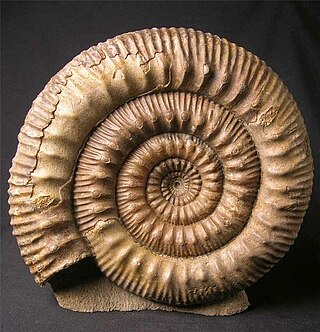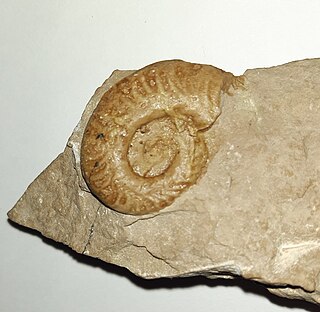
Dactylioceras was a widespread genus of ammonites from the Lower Jurassic period, approximately 180 million years ago (mya).

Stephanoceras is an extinct genus of Stephanoceratoid ammonite which lived during the Bajocian. It is the type genus of the family Stephanoceratidae.

Arnioceras is an extinct genus of large, evolute, discoidal ammonite from the Lower Jurassic. The shell is normally coiled so that all whorls are exposed. Sides bear strong sharp ribs that are straight until reaching the ventrolateral edge where they swing forward and fade. The rim (venter) is keeled and free of grooves.

Berriasella is a discoidal evolute perisphinctacean ammonite, and type genus for the neocomitid subfamily Berriasellinae. Its ribbing is distinct, consisting of both simple and bifurcated ribs that extend from the umbilical seam across the venter; its whorl section generally compressed, the venter more or less narrowly rounded. The species Berriasella jacobi traditionally has been regarded an index fossil defining the base of the Cretaceous, however since 2016 this had been replaced by the first occurrence of Calpionella alpina. Some authors regard B. jacobi as instead belonging to the genus Strambergella.
Phaulostephanus is an extinct genus from the ammonoid family Stephanoceratidae, which is part of the ammonitid superfamily Stephanoceratoidea, that lived during the early Middle Jurassic.

Hildoceras is a genus of ammonite from the Jurassic period in the family Hildoceratidae. The shells are characterized by a narrow discoidal evolute shape, keeled venter, concave ribs along the outer flanks, and a shallow spiral groove running along smooth inner flanks. Whorls slightly overlap, cross sections are compressed. The ventral keel is bordered on either side by a shallow groove. The genus was named by Alpheus Hyatt after Saint Hilda in 1876.

The family Dactylioceratidae comprises Early Jurassic ammonite genera with ribbed and commonly tuberculate shells that resembled later Middle Jurassic stephanoceratids and Upper Jurassic perisphinctids. Shells may be either evolute or involute.

Harpoceras is an extinct genus of ammonite belonging to the family Hildoceratidae. These cephalopods existed in the Jurassic period, during the Toarcian age from the Falciferum zone to the Commune subzone of the Bifrons zone. They were fast-moving nektonic carnivores.
Tokurites is a monospecific genus of ammonite that lived during the Toarcian stage of early Jurassic, ammonite zone of Zugodactylites braunianus. Its shell has ribs, which cross the ventral part of the shell creating pricky tubercules there. By these tubercules, it differs from any other member of Dactylioceratidae. This genus is closely related to genus Reynesoceras. The genus is based on the single specimen with diameter of 15 mm and thus consist from only one species Tokurites inopinatus. This is the only specimen that has been found in the Asian part of Russia.
Reynesocoeloceras is genus of ammonite that lived during the lower Pliensbachian stage of early Jurassic, ammonite zones Ibex—Davoei.
Porpoceras is genus of ammonite that lived during the early and middle Toarcian stage of early Jurassic. Members of this genus existed from uppermost part of the Harpoceras serpentinum zone to the Haugia variabilis zone. Their fossils were found in Europe, Asia, North America and South America.
Septimaniceras is genus of ammonites that has probably evolved from Peronoceras and lived during the middle Toarcian stage of early Jurassic. Members of this genus existed from Bifrons Subzone to lower part of Variabilis Subzone. Their fossils were found in France, Hungary and probably also in Austria.
Collina is genus of ammonite that lived during lower to upper Toarcian stage of early Jurassic. Members of this genus existed from Braunianus Subzone to Variabilis Zone. Their fossils were found in Europe, Asia, North America and South America. It has evolved from Mesodactylites.

Catacoeloceras is a genus of ammonite that lived during Middle Toarcian stage of early Jurassic. Members of this genus existed from the Bifrons Subzone of the Bifrons Zone to the Variabilis Zone. Their fossils have been found in Europe, northern Africa, Asia, North America and South America. It is believed to have evolved from Porpoceras.
Nodicoeloceras is genus of ammonite that lived during early to middle Toarcian stage of early Jurassic. Members of this genus existed from Exaratum Subzone of Falciferum Zone to Commune subzone of Bifrons Zone. Their fossils were found in Europe, northern Africa, Asia, North America and South America. It has probably evolved from Dactylioceras (Orthodactylites) or Kedonoceras and gave rise to Mesodactylites.
Mesodactylites, which is sometimes considered to be a synonym of Nodicoeloceras is genus of ammonite that lived during early to middle Toarcian stage of early Jurassic. Their fossils were found in southern and central Europe and northern Africa. It has evolved from Nodicoeloceras.
Transicoeloceras, which is sometimes considered to be a synonym of Catacoeloceras is genus of ammonite that lived during Toarcian stage of early Jurassic. Their fossils were found in Hungary, Italy, France, southern Spain and South America. It has evolved from Mesodactylites.
Telodactylites, which is sometimes considered to be a synonym of Porpoceras is genus of ammonite that lived during Toarcian stage of early Jurassic. Their fossils were found in Europe, northern Africa and South America. It has probably evolved from Mesodactylites.

The subfamily Dactylioceratinae comprises early Jurassic ammonite genera that lived during Upper Pliensbachian to Upper Toarcian stage. These dactylioceratids existed from Margaritatus ammonite Zone, when they have evolved from Reynesocoeloceratinae and died out in Variabilis Zone without leaving any descendants.
Microdactylites, which is sometimes considered to be a synonym of Dactylioceras, is genus of ammonite that lived during early to middle Toarcian stage of early Jurassic. Their fossils were found in England, France, Italy, Germany and Hungary. Species belonging to this genus were microconchs of Dactylioceras.








